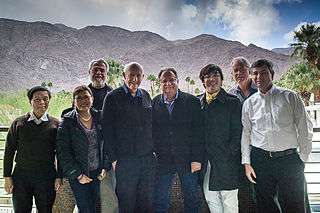Vietnamese Nôm Preservation Foundation
|
Hội Bảo Tồn Di Sản Chữ Nôm 會保存遺産喃 | |
 | |
| Abbreviation | VNPF |
|---|---|
| Formation | 1999 |
| Type | NGO |
| Legal status | active |
| Purpose | Language preservation |
| Headquarters | Cary, North Carolina |
| Location |
|
| Fields | Linguistics |
Official language | English, Vietnamese |
President | Prof. John Balaban |
| Website |
nomfoundation nomfoundation |
| Vietnamese Nôm Preservation Foundation | |||||||||
| Chinese name | |||||||||
|---|---|---|---|---|---|---|---|---|---|
| Traditional Chinese | 喃字遺產保護會 | ||||||||
| Simplified Chinese | 喃字遗产保护会 | ||||||||
| |||||||||
| Vietnamese name | |||||||||
| Vietnamese alphabet | Hội Bảo Tồn Di Sản Chữ Nôm | ||||||||
| Hán-Nôm |
會保存遺産喃 or 會保存遺産𡨸喃 | ||||||||
The Vietnamese Nôm Preservation Foundation (Vietnamese: Hội Bảo Tồn Di Sản Chữ Nôm; Hán Nôm: 會保存遺産喃), shortened as the Nôm Foundation[1] and abbreviated as VNPF, is an American nonprofit agency for language preservation headquartered in Cary, North Carolina, with an office in Hanoi, Vietnam.[2] Established in 1999, it has been engaging in the preservation of Chữ Nôm script (an ancient, logographic, Chinese character-based script once used by the Vietnamese people to write their language) remained in manuscripts, inscriptions and woodblocks.[3][4]
Foundation
The preservation of Chữ Nôm practiced by the Foundation involves different approaches, such as the electronic font carving, ideograms entered into Unicode and the International Standard (regulated by ISO), digitization for displaying Nôm on the Internet and the revival of ancient works in literature, history, culture, musics and the arts (e.g. the chamber music called Ca trù).[5]
With the help of voluntary linguists, lexicographers and computer professionals from many part of the world, the VNPF publishes Nôm dictionary in both print edition and digital format, making it the first Nôm dictionary in True Type.[3][5] While granting scholarships to American and Vietnamese students who intend to research this subject,[3] the VNPF also sponsored two international Nôm conferences and represented Nôm script at the international meetings held by the Ideographic Rapporteur Group.[5][6]
Projects
There has been a scheme called the Digitization Project of the Hán-Nôm Special Collection cooperatively implemented by the Vietnamese Nôm Preservation Foundation and the National Library of Vietnam. In 2006, a Memorandum was signed by the VNPF, enabling it to build a digital library based on the existing collections in the National Library which stores world's most ancient scripts written in Hán Nôm.[5] Through the resources from the National Library, the VNPF had digitized more than 2000 Hán Nôm texts till 2013.[4]
Meanwhile, the VNPF has been directing another project to digitize the Thắng Nghiêm Temple (Vietnamese: Chùa Thắng Nghiêm; Hán Nôm: 寺勝嚴) near Hanoi. Constructed in the early 11th century under an imperial order, it is an important historical site for the Asian Buddhism. The project will be completed by 2014, bringing a web database of the full record from the Temple, including manuscripts, epigraphical materials and visual heritages in Chữ Nôm. Additionally, the building structure and iconographical ideas of the Thắng Nghiêm Temple will be shown in a photographic overview.[7]
Receiving funds from private donators, the Chino Cienega Foundation in California, the International Music and Arts Foundation in Liechtenstein, North Carolina State University and the U.S. Embassy in Hanoi, this project is aimed at recording Vietnamese Buddhism, offering historical documents of the Temple, opening a path for further temple digitization in the future and letting the materials to be globally accessible.[7]

Staff
Since 1999, Professor John Balaban at North Carolina State University has been the president of the VNPF. In 2000, he published his influential book Spring Essence: The Poetry of Ho Xuan Huong (written in both chữ quốc ngữ and Hán Nôm), which was the first Nôm book ever printed in the modern times.[6] Dr. Ngô Thanh Nhàn, a Vietnamese characters researcher at Temple University and a computational linguist at New York University, was the vice president from 1999 to 2007.[8][9] Currently the VNPF has two vice presidents (Ngô Trung Viet[10] and Brad Crittenden[11]) and one secretary/treasurer (Stephen O. Lesser).[11]
See also
- The Institute of Hán-Nôm Studies, a similar research center in Hanoi, Vietnam.
References
- ↑ "Vietnamese Nôm Preservation Foundation". Library of Congress Name Authority File. Retrieved August 5, 2014.
- ↑ "Contact". Vietnamese Nôm Preservation Foundation. Retrieved August 8, 2014.
- 1 2 3 "About the VNPF". Vietnamese Nôm Preservation Foundation. Retrieved August 4, 2014.
- 1 2 Balaban, John (filed by Victor Mair on July 16, 2013). "Update on Nom". Language Log, Linguistic Data Consortium, the University of Pennsylvania. Retrieved August 4, 2014. Check date values in:
|date=(help) - 1 2 3 4 Balaban, John. "The Hán-Nôm Special Collection Digitization Project". Southeast Asia Digital Library, Northern Illinois University. Retrieved August 4, 2014.
- 1 2 "Preservation of the Vietnamese Nôm Script". Asia Research Centre, the London School of Economics and Political Science, the University of London. Retrieved August 4, 2014.
- 1 2 Schmid, D. Neil. "Digitizing a Vietnamese Buddhist Temple: The Vietnamese Nôm Preservation Foundation's Thắng Nghiêm Temple Project". Centre for the Study of Religion and Culture in Asia, the University of Groningen. Academia.edu. Retrieved August 5, 2014.
- ↑ "Contact". the Center for Vietnamese Philosophy, Culture & Society, College of Liberal Arts, Temple University. Retrieved August 4, 2014.
- ↑ "Ngô Thanh Nhàn". Computer Science Department, New York University. Retrieved August 5, 2014.
- ↑ Oronte (July 20, 2007). "What Ngo Trung Viet Knows". Inside Higher Ed. Retrieved August 5, 2014.
- 1 2 "The people". Vietnamese Nôm Preservation Foundation. Retrieved August 5, 2014.
External links
Tools provided by the VNPF
- "Nôm Lookup Tool". the Vietnamese Nôm Preservation Foundation. Retrieved August 8, 2014.
- "Nôm Dictionary". the Vietnamese Nôm Preservation Foundation. Retrieved August 8, 2014.
Research production
- "The Han-Nom Special Collection Digitization Project: Digitized selected manuscripts from the Vietnamese Nom Preservation Foundation". Southeast Asia Digital Library, Northern Illinois University. Retrieved August 4, 2014.